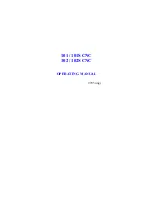
8
D
9
www.roco.cc
GB
Key Assignment and display: Fig. 1
Connection Diagram: Fig. 2
The RouteControl unit 10772 must not be
connected to any equipment made by other
manufacturers; only to the ROCO Central
10751, the ROCO amplifier 10761 or the
Lenz LZ 100 and LV 101.
General
The RouteControl permits easy control of turnouts
with or without end-of-stroke disconnect or position
controls for for call-up of track routes. It can be used
either at the
DataBUS
with Lokmaus
2
®
(10760/
10790)/Power Mouse™(10860, US only) and the
amplifier 10761
together with Lenz units, or at the
“
Maus-Bus“
with the
Lokmaus
1
®
(10750)
and
the central unit 10751.
The RouteControl announces itself after start of
the “Lokmaus
®
“ system, after being plugged into
the “Lokmaus
®
“ system or the return from the set-
ting menu (refer to
Settings
), at first with “CON“
(meaning “RouteControl“), followed by display of
the number of the last activated magnetic device or
of the last called track route.
When using the “
Maus-Bus”
system it is only pos-
sible to use a single RouteControl. Since the Central
unit 10751 does not store the position of the turnout
there is no return indication of the actual position of
the turnout. The green and red light-emitting diodes
(LEDs) merely represent the last issued command.
When using the
DataBUS
up to 10 units contain-
ing at most 2 RouteControl units can be used (the
number depends on the booster or central unit in
use). When using the RouteControl in conjunction
with the Lokmaus
2
®
both LEDs will show the last
issued turnout command. In this case of the Lokmaus
2
®
takes care of the storing of the turnout position. If
neither of the two LEDs is illuminated the central unit
(e.g. the Lokmaus
2
®
acting as master) has not yet
indicated this turnout as having been operated.
The actual position of the turnout will only be shown
at both LEDs if a return indication by the turnout or
the switch receiver has been received and the ampli-
fier or booster used supports this return indication
(not when 10761 or 10762 is used!).
Number of controllable turnout numbers:
â
with “Maus-Bus” operation: 1 to128
â
with DataBUS operation: 1 to 256
number of callable track routes: in both operating
modes: 32
To change unit addresses refer to the tables “Menu
system“.
“Maus-Bus”-Operation and Data-
BUS-Operation
To use the RouteControl it is necessary to use the
matching cable depending on the system used (see
fig. 2):
â
„Maus-Bus”-operation:
use cable with 5-
pole DIN plug (round) / western plug;
â
DataBUS-operation:
use cable with 6-pole
western plug / western plug (both ends). Only the
slave socket of the amplifier 10761 may be used!
Control of turnouts and track routes
The number of the turnout to be operated is en-
tered into the display using the keys 0...9 or the
cursor keys. The turnout is operated with the
keys
“straight/ok“
or “diverging/esc“
. When run-
ning the
cursor
straight up the track route numbers
will be found after the last turnout number 128
(Lokmaus
1
®
system) or 256 respectively (Lokmaus
2
®
system) starting with F.01.
The
green and red LED
provide information
concerning the last given turnout command within
the Maus-Bus or DataBUS system, also about the
setting of the turnout as long as turnout motor
and amplifier/booster are capable of giving return
indications.
If a number is entered which exceeds the valid region
the highest possible turnout address in the system
is displayed. The input of the address 000 by single
turnout control is not possible; neither is the input of
zeros ahead of otherwise one- or two digit numbers.
For instance: if turnout 5 shall be operated the input
of “5“ is sufficient: without any additional command
the missing, leading zeros are automatically added
to show “005“ after 2 seconds (variable delay). If
the direction key red or green is pressed immediately
following the numerical input the leading zeros are
immedately added.
Errorneous inputs are simply replaced by a repeated
one-to-three digit numerical input or a change with
the red or green direction keys. During prolonged
activation of the direction keys the corresponding
LED will blink to indicate that a setting command
has already been given for this direction.









































